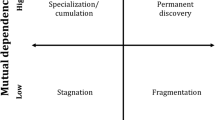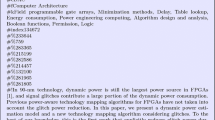Abstract
This article examines the communication networks within and between science and technology studies (STS) and the history of science. In particular, journal relatedness data are used to analyze some of the structural features of their disciplinary identities and relationships. The results first show that, although the history of science is more than half a century older than STS, the size of the STS network is more than twice that of the history of science network. Further, while a majority of the journals in the STS network are connected by weak ties, about half of the history of science network consists of strong ties. The history of science network is thus more cohesive than the STS network. The relatively strong cohesion within the history of science network is associated with comparatively high degrees of intra-disciplinary communication, but comparatively weak ties to only a few related disciplines. The analysis also shows that very few members of the history of science cliques are situated on the shortest path between both specialties. Moreover, given the relatively impermeable nature of the history of science network, the latter partially depends on STS to reach some of the neighboring disciplines.



Similar content being viewed by others
Notes
The first issue of Minerva also appeared in 1962. As specified in its first editorial, Minerva chose to focus upon the ‘new situation’ of science and scholarship, especially in the context of the university.
All in all, these results strongly support our selection of the relevant entrance journals.
Isis was originally a multilingual journal. Sarton’s programmatic statement was written in French. We quote here from a slightly revised English translation, which was first published in 1916 and reprinted in Sarton’s The life of science (1948).
References
Abbott, Andrew. 2005. Linked ecologies: states and universities as environments for professions? Sociological Theory 23(3): 245–274.
Archambault, Éric, and Étienne Vignola Gagné. 2004. The use of bibliometrics in the social sciences and humanities. Montréal: Science-Metrix.
Borgatti, Steve P., Martin G. Everett, and Linton C. Freeman. 2002. Ucinet 6 for Windows: Software for social network analysis. Harvard: Analytic Technologies.
Borgatti, Steve P. 2002. NetDraw: Graph visualization software. Harvard: Analytic Technologies.
Broad, William J. 1980. History of science losing its science. Science 25 January: 389.
Campbell, Donald T. 1969. Ethnocentrism of disciplines and the fish-scale model of omniscience. In Interdisciplinary relationships in the social sciences, eds. Muzafer Sherif, and Carolyn W. Sherif, 328–348. Chicago: Aldine.
Cohen, I. Bernard. 1999. The Isis crises and the coming of age of the history of science society—With notes on the early days of the Harvard program in history of science. Isis 90: S28–S42.
Daston, Lorraine. 2009. Science studies and the history of science. Critical Inquiry 35(4): 798–813.
Dear, Peter, and Sheila Jasanoff. 2010. Dismantling boundaries in science and technology studies. Isis 101(4): 759–774.
Dubrow, Joshua Kjerulf. 2011. Sociology and American Studies: A case study in the limits of interdisciplinarity. The American Sociologist 42(4): 303–315.
Edge, David. 1977. Why I am not a co-citationist. Society for Social Studies of Science Newsletter 2: 13–19.
Granovetter, Mark. 1973. The strength of weak ties. The American Journal of Sociology 78(6): 1360–1380.
Hackett, Edward J., Olga Amsterdamska, Michael Lynch, and Judy Wajcman. 2008. The handbook of science and technology studies, 3rd ed. Cambridge, MA: MIT Press.
Heilbron, Johan, Nicolas Guilhot, and Laurent Jeanpierre. 2008. Toward a transnational history of the social sciences. Journal of the History of the Behavioral Sciences 44(2): 146–160.
Hicks, Diana M. 2004. The four literatures of social science. In Handbook of Quantitative Social Science and Technology Research, eds. Henk Moed, Wolfgang Glänzel and Ulrich Schmoch, 473-496. Kluwer Academic,.
Jasanoff, Sheila. 2000. Reconstructing the past, constructing the present: Can science studies and the history of science live happily ever after? Social Studies of Science 30(4): 621–631.
Kuhn, Thomas. 1984. Professionalization recollected in tranquility. Isis 75(1): 29–32.
Larivière, Vincent, Éric Archambault, Yves Gingras, and Étienne Vignola-Gagné. 2006. The place of serials in referencing practices: comparing natural sciences and engineering with social sciences and humanities. Journal of the American Society for Information Science and Technology 57(8): 997–1004.
Lenoir, Timothy. 1979. Quantitative foundations for the sociology of science: On linking blockmodeling with co-citation analysis. Social Studies of Science 9: 455–480.
Leydesdorff, Loet. 1989. The relations between qualitative theory and scientometric methods in science and technology studies. Scientometrics 15(5–6): 333–347.
Maienschein, Jane. 2009. From the president. Newsletter of the History of Science Society 38(3): 14–15.
Martin, Ben R., Paul Nightingale, and Alfredo Yegros-Yegros. 2012. Science and technology studies: Exploring the knowledge base. Research Policy 41(7): 1182–1204.
Merton, Robert K. 1985. George Sarton: Episodic recollections by an unruly apprentice. Isis 76(4): 470–486.
Otte, Evelien, and Ronald Rousseau. 2002. Social network analysis: A powerful strategy, also for the information sciences. Journal of Information Science 28(6): 441–453.
Park, Han Woo, and Loet Leydesdorff. 2009. Knowledge linkage structures in communication studies using citation analysis among communication journals. Scientometrics 81(1): 157–175.
Prévost, Jean-Guy. 2009. A total science: Statistics in liberal and fascist Italy. Montréal: McGill-Queen’s University Press.
Pudovkin, Alexander I., and Eugene Garfield. 2002. Algorithmic procedure for finding semantically related journals. Journal of the American Society for Information Science and Technology 53(13): 1113–1119.
Putnam, Robert D. 2000. Bowling alone: The collapse and revival of American community. New York: Simon & Schuster.
Sarton, George. 1913. L’histoire de la science. Isis 1(1): 3–46.
Sarton, George. 1948. The life of science. New York: Schuman.
Sarton, George. 1952. A guide to the history of science. Massachusetts: Waltham.
Shapin, Steven. 1982. History of science and its sociological reconstructions. History of Science 20: 157–211.
Shapin, Steven. 1992. Discipline and bounding: The history and sociology of science as seen through the externalism-internalism debate. History of Science 30: 333–369.
Stichweh, Rudolf. 1984. Zur Entstehung des modernen Systems wissenschaftlicher Disziplinen. Physik in Deutschland 1740–1890. Frankfurt a.M: Suhrkamp.
Sullivan, Daniel, D. Hywel White, and Edward J. Barboni. 1977. Co-citation analyses of science: An evaluation. Social Studies of Science 7(2): 223–240.
van den Besselaar, Peter. 2000. Communication between science and technology studies journals: A case study in differentiation and integration in scientific fields. Scientometrics 47(2): 169–193.
van den Besselaar, Peter. 2001. The cognitive and the social structure of STS. Scientometrics 51(2): 441–460.
Vanderstraeten, Raf. 2010. Scientific communication: Sociology journals and publication practices. Sociology 44(3): 559–576.
Vanderstraeten, Raf. 2011. Scholarly communication in education journals. Social Science History 35(1): 109–130.
Wray, K. Brad. 2010. Philosophy of science: what are the key journals in the field? Erkenntnis 72(3): 423–430.
Author information
Authors and Affiliations
Corresponding author
Appendices
Appendix 1: Out-Degrees and In-Degrees of the Entrance Journals (Strong to Moderate Ties Only)
Appendix 2: Clique Analysis (Minimum Set Size = 5)
Rights and permissions
About this article
Cite this article
Vandermoere, F., Vanderstraeten, R. Disciplinary Networks and Bounding: Scientific Communication Between Science and Technology Studies and the History of Science. Minerva 50, 451–470 (2012). https://doi.org/10.1007/s11024-012-9210-x
Published:
Issue Date:
DOI: https://doi.org/10.1007/s11024-012-9210-x




